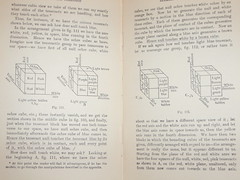

-From C.H. Hinton (click for larger pictures)
Charles H. Hinton, the author of the 1906 book The Fourth Dimension, believed he had developed a system that would allow anyone to actually visualize the fourth spatial dimension. He went one further and invented a set of colored cubes that, if used properly, would develop this 4th spatial sense.
The 2nd dimension is best visualized as a piece of paper. Inhabitants of this piece of paper can move left or right (1 dimension), backwards and forward (2nd dimension) but cannot move out of the paper up or down (3rd dimension). We are three dimensional creatures who live in a three dimensional space. The fourth dimension is yet another "direction" that we cannot point to, anymore than an inhabitant of the piece of paper can point out of the page.
Hinton was the son-in-law of the famous logician George Boole, the inventor of Boolean logic. He was obsessed with the possibilities of the fourth dimension and published several books on the subject.
His visualization attempts focused on the Tesseract, a word which he coined himself and made its way into popular culture, for example in Madeleine L'Engle's children's book A Wrinkle in Time. A Tesseract is a four-dimensional object which completes the following analogy:
Square (2-d) is to Cube (3-d) as Cube (3-d) is to Tesseract (4-d)
A Tesseract wont fit into our universe. Although, we can construct both the shadow a Tesseract would make onto our plane and we can also construct an unfolded Tesseract. An unfolded Tesseract, for example, is the cross that Christ hangs from in Salvador Dali's Corpus Hypercubus.
The premise behind Hinton's colored cubes is that with sufficient exercise one can develop an intuition for how four-dimensional objects move and rotate in our space. Although it makes no sense at first, the properties of four-dimensional objects are well-defined and known precisely.
After a period of limited popularity, Hinton and his strange cubes lapsed into obscurity. They were re-discovered again in the 1950's when they were featured in an article in Scientific American by Martin Gardner. Gardner presented some of the same history I have given here. Shortly after the publication of his article, he received a series of letters from readers who were both amazed and also a little concerned about the rediscovery of the cubes. Here is one such letter:
Dear Mr. Gardner:
A shudder ran down my spine when I read your reference to Hinton's cubes. I nearly got hooked on them myself in the nineteen-twenties. Please believe me when I say that they are completely mind-destroying. The only person I ever met who had worked with them seriously was Francis Sedlak, a Czech neo-Hegelian Philosopher (he wrote a book called The Creation of Heaven and Earth) who lived in an Oneida-like community near Stroud, in Gloucestershire.
As you must know, the technique consists essentially in the sequential visualizing of the adjoint internal faces of the poly-colored unit cubes making up the larger cube. It is not difficult to acquire considerable facility in this, but the process is one of autohypnosis and, after a while, the sequences begin to parade themselves through one's mind of their own accord. This is pleasurable, in a way, and it was not until I went to see Sedlak in 1929 that I realized the dangers of setting up an autonomous process in one's own brain. For the record, the way out is to establish consciously a countersystem differing from the first in that the core cube shows different colored faces, but withdrawal is slow and I wouldn't recommend anyone to play around with the cubes at all.
After Gardner's article and another small revival, the cubes were again forgotten. Recently the author Rudy Rucker has also tried to revive interest in Hinton's toys. Although I haven't felt the urge to do so, my copy of Hinton's book gives all the details for constructing the cubes.
No comments:
Post a Comment